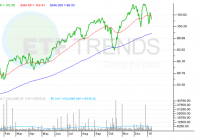Mining ETFs Crumble On Copper Collapse
Acting as a leveraged play on the underlying commodities, metal & mining stocks, and ETFs have been under pressure over the last two years on weak global commodity trends. The year 2015 might dig up the same sad story, with perhaps more pain in store. Geopolitical tensions, global growth uncertainty, oil price havoc, strong dollar, and global supply glut continue to weigh on this corner of the space. Notably, a rising U.S. currency makes dollar-denominated assets more expensive to foreign investors, thereby dulling the appeal for the commodities. Inside the Slump The most recent plunge came from a broad selloff in the industrial metal sector on Tuesday and Wednesday. Copper was hit the hardest, plunging to below the five-year low. The red metal is vital to the growth of the global economy as it is a raw material in construction and manufacturing activities. About 45% of the demand comes from China, which is struggling with slow growth and thus weak consumption. Lead dropped to a 31-month low, nickel close to a one-year low, while zinc and aluminum are trading at eight- and seven-month lows, respectively. The downward revision to the global outlook this week by the World Bank unnerved investors across the board. The bank lowered its global growth forecast to 3% from 3.4% for 2015 and to 3.3% from 3.5% for 2016. This is primarily thanks to sluggishness in Euro zone, recession in Japan, and weakness in key emerging markets like Russia, Brazil and China despite the stronger U.S. economy. Further, oil price is not showing any signs of reversing, raising fears of deflation across the globe. Adding to the woes is Citigroup’s reduced price target for iron ore to $58 and $62 for 2015 and 2016, respectively, from $65 for both years. Further, it stated, “the industrial commodities are being in the midst of a deflationary spiral, driven by lower oil prices, falling fx and efficiency gains.” The firm also expects earnings of major miners to fall 9-21% in 2015 and 3-16% in 2016. Given this, the mining stocks have seen terrible trading with most of them losing in double digits in the last two sessions. Below, we have highlighted three ETFs that slipped to multi-year lows and could see steeper falls in the days ahead if the current trends persist. SPDR S&P Metals & Mining ETF (NYSEARCA: XME ) This ETF offers broad exposure to the metal and mining industry by tracking the S&P Metals & Mining Select Industry Index. Holding 36 stocks in its basket, it uses an equal weight methodology and does not put more than 4.4% of assets in a single security. In term of industrial exposure, steel makes up for large chunk at 39%, while coal & consumable fuels, and diversified metal and mining round out the top three. The product has $347.7 million in AUM and is liquid with solid trading volumes of more than 2 million shares per day on average. It charges 35 bps in fees and expenses. The fund slid to a multi-year low of $26.89, having lost about 10.5% so far in the year. iShares MSCI Global Metals & Mining Producers ETF (NYSEARCA: PICK ) This fund follows the MSCI ACWI Select Metals & Mining Producers Ex Gold & Silver Investable Market Index, which provides global exposure to companies that are involved in the extraction and production of diversified metals, aluminum, steel, and precious metals and minerals. It has amassed $159.5 million in its asset base while trades in light volume of under 50,000 shares. Expense ratio came in at 0.39%. The ETF holds a broad basket of 209 securities with the largest allocation to BHP Billiton (NYSE: BHP ) and Rio Tinto Plc (NYSE: RIO ) with 10.9% and 8.4% share, respectively. About three-fifths of the portfolio is dominated by metals & mining, closely followed by steel (32%). Australia, U.S. and United Kingdom are the top three countries with double-digit allocation. PICK has dropped 8.7% so far this year to an all-time low of $14.22. Global X Copper Miners ETF (NYSEARCA: COPX ) This ETF targets the copper mining industry across the globe. It follows the Solactive Global Copper Miners Index and holds 25 stocks in its basket with none holding more than 6.25% share. In terms of a national breakdown, Canada takes the top spot with 36% of assets while Australia, Mexico and United Kingdom round out the next three spots with double-digit exposure. The product has managed $19.9 million in AUM while charges 65 bps in fees per year. It trades in light volume of 37,000 shares a day on average. The fund lost about 16% in the first few days of 2015 and hit an all-time low of $6.07.
